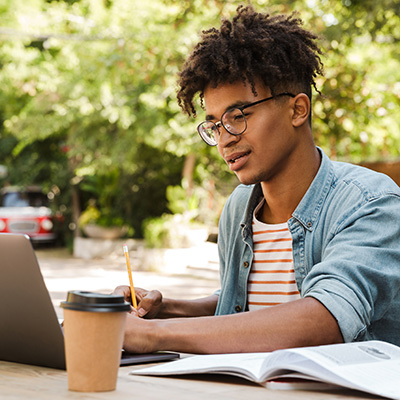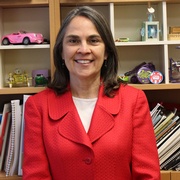STEM Education and Youth Who are Disabled: We're Overdue for Inclusivity
By Linda Kekelis, PhD | December 11, 2018
Advisor, STEM Next Opportunity Fund
We need to build greater diversity in STEM education. Like a lot of my colleagues, I’ve worked to create programs welcoming more girls and youth of color into STEM. We’ve made good progress, and we are creating positive momentum.
But one group that continues to be overlooked, even within strong and established programs, is youth who are disabled. I’ve had an opportunity to contribute to STEM programs reaching youth who are blind and visually impaired. I believe lessons learned in these efforts can help others build greater inclusivity in their STEM education programs. I hope you’ll take a look at our recent case study, developed through STEM Next Opportunity Fund, which outlines the programs we designed and some of our lessons learned.
This is a matter of fairness and social justice. But it’s about far more than being “fair” to individuals who have been left out of the picture. It’s about creating a more robust, innovative, rewarding and profitable environment for everyone. In fact, a recent report by Accenture found that companies following best practices for inclusion of individuals with disabilities had greater revenue, double the net income and a 30 percent higher profit margin than their less inclusive peers.
Parent and Advocates
 I’ve had a longtime interest in children who are disabled and their families. My doctoral research explored language development in children who were visually impaired. I learned that parental expectations and opportunities had a significant impact on what children were able to achieve. These are principles I brought with me as I began to focus on STEM education. Family engagement in STEM learning has continued to be a great passion of mine.
I’ve had a longtime interest in children who are disabled and their families. My doctoral research explored language development in children who were visually impaired. I learned that parental expectations and opportunities had a significant impact on what children were able to achieve. These are principles I brought with me as I began to focus on STEM education. Family engagement in STEM learning has continued to be a great passion of mine.
Family engagement is as vital for youth who have a sensory impairment as for any other group. Often, these children’s parents are their greatest advocates. Time and again, I have attended conferences where the voices raising issues of inclusivity for the disabled are the parents of those youth. It is time for all of us to be thinking about these issues. We all need to add our voices to the call for equity and inclusivity.
Students Who are Blind and Visually Impaired and STEM
Most of the activities and resources for traditional STEM education have a strong visual component. It is not surprising that students who are blind and visually impaired do not often participate in traditional after-school STEM programs. In-school STEM opportunities are often limited as well. Because of a lack of training on these issues, some educators find it difficult to imagine how to adapt traditional activities to work for students who are visually impaired.
This is why students who are blind or visually impaired sometimes find themselves paired with sighted partners for activities. Instead of hands-on experience, they listen to a verbal description of an exercise or museum exhibit. The educational impact is not equivalent.
 Techbridge Girls, the organization I founded, partnered with the California School for the Blind to develop a program that could offer a greater range of experiences for students who are blind and visually impaired. We began by asking the students what kind of activities they wanted. Their answers were similar to those of other students: they wanted hands-on projects, field trips, and time to talk with people working in STEM fields about career opportunities.
Techbridge Girls, the organization I founded, partnered with the California School for the Blind to develop a program that could offer a greater range of experiences for students who are blind and visually impaired. We began by asking the students what kind of activities they wanted. Their answers were similar to those of other students: they wanted hands-on projects, field trips, and time to talk with people working in STEM fields about career opportunities.
Working with staff and students, and with the help of the Chabot Space & Science Center, we developed a range of exciting activities. Fairly straightforward adaptations made these hands-on exercises accessible to the students:
- A simulated mission to space (using large-print and braille manuals so students could monitor gauges and assemble probes).
- A kite-building activity that helped students learn about engineering design and aerodynamics, and included the experience of running with a kite in flight (with the help of a partner).
- Robot-building kits (using magnetic screwdrivers and divided trays that helped keep the many small nuts and screws organized).
- Cow eye dissection (focusing on touch, texture and form—described in more detail here).
- Electrical wiring (using Snap Circuits rather than a hot soldering iron).
These were powerful experiences for students and their families and educators. They opened up new possibilities and encouraged students to dream about future aspirations.
I Want to Be a Marine Biologist
When one student expressed interest in marine biology, she was advised that it wouldn’t be possible because she was blind. The adults in her life weren’t trying to limit her aspirations. They just couldn’t imagine how she could pursue such a course of study. They hadn’t seen any role models—any persons with a visual impairment portrayed in a movie or book who was a marine biologist, chemist or engineer.
Staff at the California School for the Blind were able to assist in supporting an internship for this student at California’s Año Nuevo State Park, famous for its shoreline elephant seal colony. The young woman led tours for visitors, helping them pay attention to all of the senses that enriched their experience of the colony’s wonders. She was also able to lead tours for other blind and visually impaired students, acting as a powerful role model for them.
The internship boosted confidence in her career aspirations. It also served to educate Año Nuevo staff and interns on new ways to understand the elephant seal colony and share the experience with park visitors.
Students Who are Deaf and Hard of Hearing and STEM
Youth who are deaf and hard of hearing have also been left out of many mainstream STEM education programs. Shireen Hafeez, founder of Deaf Kids Code, started out as a parent advocate for her son who is deaf. She envisions a future where individuals who are deaf are not merely users of technology or basic code developers, but are leading the way in innovation.
 In our recent case study (online here), Hafeez points out that children who are deaf and hard of hearing “can excel at coding by leveraging the skills they use to tackle daily challenges. Our children are natural innovators, problem solvers, and visionaries because they are navigating in a world that does not bend towards inclusion or accessibility….(T)hey are natural creative thinkers.”
In our recent case study (online here), Hafeez points out that children who are deaf and hard of hearing “can excel at coding by leveraging the skills they use to tackle daily challenges. Our children are natural innovators, problem solvers, and visionaries because they are navigating in a world that does not bend towards inclusion or accessibility….(T)hey are natural creative thinkers.”
Deaf Kids Code supports the opportunity for youth to aspire to tech careers. Students participate in job shadows, field trips and internships. They are encouraged to imagine new ways to design and deliver technology and to see themselves as creators of tech. After Deaf Kids Code workshops, 95 percent of participants want to keep learning about coding and say they can see themselves pursuing a STEM-based career.
Parents: Eager to Be Engaged
It is vital that parents of kids who are blind and deaf share in their children’s dreams and aspirations for STEM. Their belief in their children’s abilities to pursue STEM learning is critical to students’ opportunity to fulfill their potential. Programs that want to support STEM engagement for underrepresented students can be more successful by empowering their parents through family engagement (see box).
Engagement: Key Steps for Parents of Youth Who are Disabled
In addition to parent engagement strategies we have described in other case studies, the following steps can be especially helpful to encourage parents of kids who are disabled.
- Bring parents to the table and listen to their concerns. This will help you understand their interests and importantly, find strategies to overcome the barriers they face.
- Offer personal invitations. These parents have repeated experiences of programs that do not offer a genuine welcome and appropriate accommodations. Let parents know that their child is truly welcome.
- Create an explicit welcome in marketing materials. Include images of children who are disabled participating actively. Let parents see, “Oh, there are kids like my child in this program.”
- Build opportunities to network with other parents. Networking can help decrease isolation, boost support and disseminate resources. It reinforces positive attitudes about their children’s STEM aspirations.
- Think broadly about accessibility. It takes more than wheelchair ramps to create accessibility. For example, students who are blind and visually impaired need environments that are easy and safe to navigate. It’s important that aides understand how to support students without limiting their learning experience.
The Girl Scouts have created excellent materials about building a culture of inclusivity for all.
Professional Development: We Don’t Have to Figure It All Out On Our Own
Professional development is an essential element of effective programs. It is an important strategy in building an organizational mindset affirming the ways inclusivity is beneficial for all students.
When we design our programs or think about funding, it is useful to plan professional development on topics related to disability. By addressing these issues, everyone can build greater capacity to think innovatively about adaptations. We can discover better ways to develop learning that makes activities and resources inclusive from the start.
Learning Without Limits
We tend to think of the term “disability” as a challenge—something is missing. But we might also consider it as describing “another way” of doing something. The story of scholar Henry “Hoby” Wedler, blind from birth, is an example of this. Though he faced challenges, he successfully obtained a PhD in organic chemistry.
In his professional career, Dr. Wedler has worked on universal accessibility—“making the world a place that can be accessible to everyone.” He also specializes in “sensory design,” addressing non-visual elements of design work. “I don’t need my eyesight to be successful,” he explains, “and if I had it, it would really be an annoyance.”
Dr. Wedler’s unique approach to the sensory world has opened up possibilities and ideas that would be difficult for a scientist who has vision to discover. In a world with ever-more challenging problems, the innovation and perception of those who do things “another way” will be increasingly important.
I hope you’ll join us in making inclusivity in STEM for youth who are disabled a priority in your programs and for the field.
Linda Kekelis, PhD, is the founder and former CEO and Executive Director of Techbridge Girls. She is a consultant who works with partners to promote participation in STEM by girls and youth who are underrepresented in STEM fields. Family engagement is one of her passions and has been at the center of her research. She is an Advisor on the Family Engagement Project at STEM Next Opportunity Fund. She can be reached at lkekelis@gmail.com. Visit STEM Next’s website to learn more about its work on family engagement.





